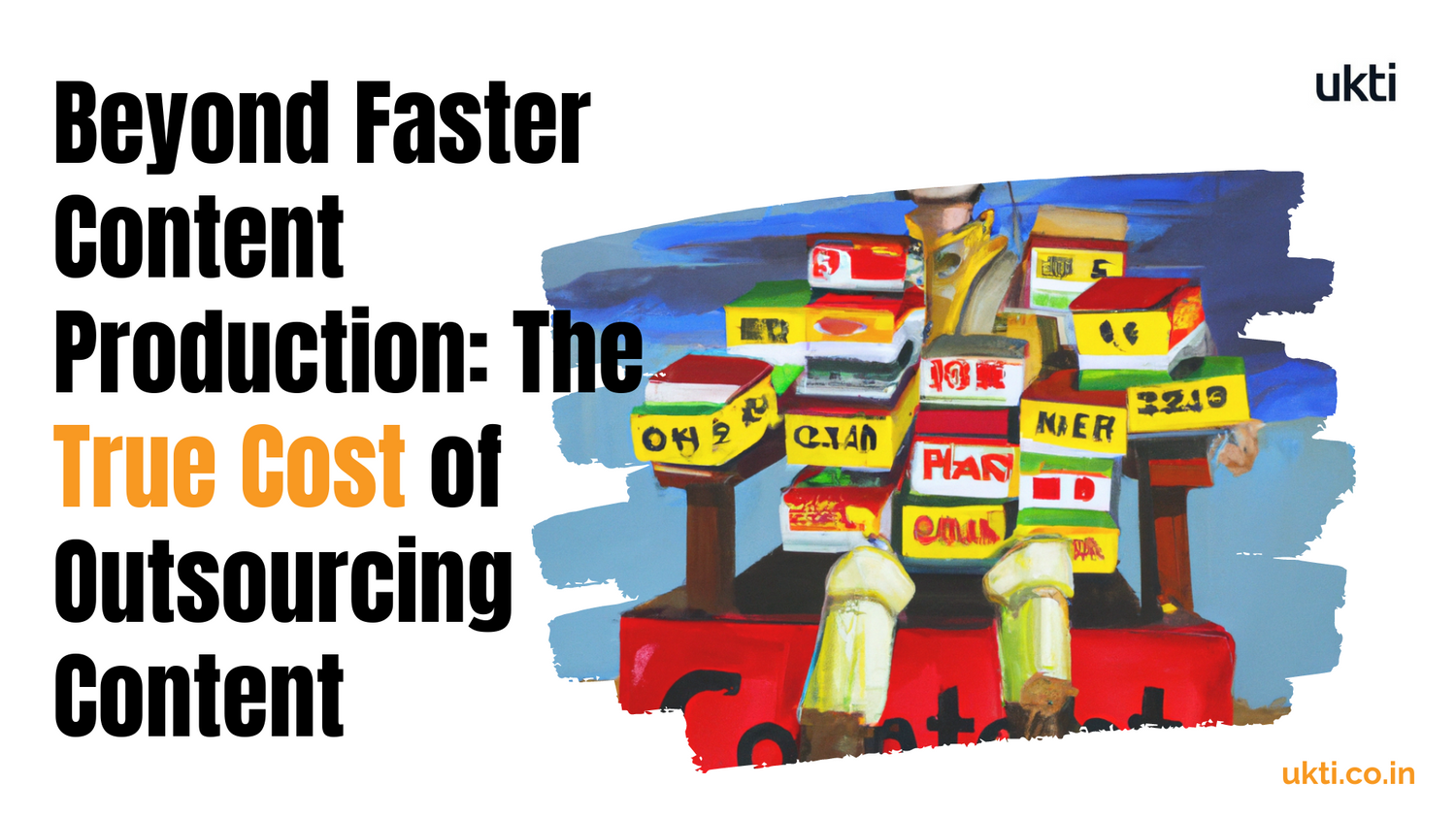Outsourcing content creation can feel like entering a pool of peers when you’re bad at swimming. A little bit of FOMO intermingled with a bit of excitement.
But it’s also one of the quickest ways to increase content production, access expertise you lack and scale your business fast. So, if you’re thinking of hiring a content creation service instead of fully insourcing, let me ask you something. And without mincing my words.
Are you 100% sure you know the price you should be paying to create content?
It’s challenging to answer, isn’t it? After all, there are too many moving parts to take care of – from creating a long-term content strategy to managing a team of content writers and content editors. But fret not! We’ve got you covered.
Here’s an unbiased in-house vs. outsourcing cost analysis to help you realize the true cost of outsourcing content creation.
But before we compare costs, let’s understand the pros and cons of in-house and outsourcing content creation.
Pros and Cons of In-House Content Creation
There are primarily two ways to in-source content creation.
1. You create content yourself
Pros
- Your content might sound more authoritative coming from you.
- Your only costs will be paid subscriptions and tools used for creating or marketing content
- Consistency in quality and messaging
Cons
- This only works if you have the time and skills to write truly valuable content within your discipline.
- You will face content scalability issues as you will need to publish more to improve brand visibility.
- This can distract you from your key focus of building your business.
- It can cause stress as any free time you have will be used to produce and publish quality content.
- You may still need to hire an SEO expert to optimise your content for search.
2. You have an in-house team
Pros
- You already trust your in-house team to provide quality content.
- It is easier to control quality as feedback loop is small.
- Your team will get direct insights from product and sales folks.
- You may have specific individuals to write on certain topics.
Cons
- Initial cost of hiring and training the team will be higher.
- You may still need to hire a dedicated editor to check compliance and quality.
- You will have to hire or redesignate people in different positions to handle content marketing, from content creation to SEO. That means paying individual salaries and benefits.
- It might take you longer to scale with the limited capacity to create content.
From hiring content writers, editors, marketers, and SEOs to assessing writer downtime and content turnover, there are too many variables to take care of when you’re insourcing content.
And keeping track of such cost levers, especially the ones that hide in plain sight, like employee benefits, salary-to-word ratio, etc., is hard.
Pros and Cons of Outsourcing Content Creation
Pros
- Get a large and experienced team on a small budget that can write authoritatively.
- There is no hidden cost of outsourcing content, as is the case with insourcing. In countries like India, you mostly pay per word.
- You can state your preference for writers with content experience in a particular field without escalating costs.
- Content scalability is no problem here. You can suddenly dial up or down the number of content you publish each month.
- You can delve into various content formats, including blogs, whitepapers, e-books, infographics, video content, and much more.
- It is the most effective hands-off approach to content marketing.
Cons
- You or your marketing team still need to devote a few minutes to sift through each content piece before publishing.
- It might cost you a little more than hiring individual freelance content writers.
- A slight learning curve may be involved if the content agency is only a few years into the business.
- It might take a few months to build trust with your content partner.
Spend some time weighing the pros and cons. This will help you understand whether outsourcing content is a good idea or a bad one at the moment.
In-House vs. Outsourcing Content: A Cost-Based Perspective
Now, coming to a pure cost analysis of the three situations.
| Scenario | Content Type and Time Consumed | Overall Cost (USD) |
| Creating content yourself | Blogposts: 3 hours E-books: 40 to 80 h ours Whitepapers: 15 to 30 hours | Unbillable but expensive. A founder or CEO creating content cuts into the time they spend doing business development and crafting growth strategies. |
| In-sourcing content to your team | Blogposts: 3 hours E-books: 40 to 80 hours Whitepapers: 15 to 30 hours Time to edit, proofread and review: 30 minutes for blogs 4 hours for e-books 2 hours for whitepapers | Content writer: 52,517 USD per year Content editor and manager: 67,841 USD per year These are two basic designations you must hire for in-house content creation. To these, you must add the following: Chief content officer: 87,865 USD per year Social media manager: 57,894 USD per year Total = 2,66,117 USD (for a barebones content team) |
| Partnering with a content agency | 0 hours spent writing. Time to edit, proofread and review: 30 minutes for blogs 4 hours for e-books 2 hours for whitepapers | Depending on the experience of the writer: 20 to 50 USD per blog post 120 to 240 USD per whitepaper 240 to 500 USD per whitepaper Total (on maximums) = 20 blogs a month = 50 x 20 =1000 USD per month =12,000 USD per year 20 whitepapers a month = 240 x 20 = 4800 USD per month = 57,600 USD per year 20 e-books a month = 500 x 20 e-books = 10,000 USD per month = 1,20,000 USD per year Total = 1,89,600 USD (for an experienced team of content specialists producing top-notch content at high speed) Of course, you won’t publish 20 e-books and whitepapers a month. However, this calculation shows you how content outsourcing is vastly cheaper, even if you did. |
All salary figures have been taken from Glassdoor | Source
Content Outsourcing is The Most Cost-Effective Option
All the human resources you hire when insourcing content creation are available when you outsource but at a fraction of the cost. You also don’t have to begin from scratch and build a team with expertise and process. This saves you a lot of quality time, and as you know, time saved is money saved.
Safe to say, outsourcing content creation is more cost-effective than insourcing.
As for quality, you often get experienced writers, some of whom have been writing for your niche for years. And you get all of this for an affordable price, whether you outsource content creation in USA, UK, or India.
“In fact, outsourcing content creation to countries like India is even more affordable. Where the average per word cost for blogs in USA ranges between 5¢ to 10¢, the same is INR 2 to 6 (0.025¢ to .074¢) in India.”
Source
But Are There Any Hidden Costs of Outsourcing Content?
When you outsource content creation to a content agency, you will typically be charged in one the following ways:
#1 Piecemeal Price: With piecemeal pricing, you are charged a flat fee for each piece of service you outsource. For example, if you only outsource blog writing services and require 10 blog posts monthly, you will only be charged for 10 blogs.
#2 Hourly Rates: As the name suggests, you are charged a fixed hourly price for a particular service. The total cost depends on the total number of billable hours.
#3 Fixed Contract-Based Price: In this case, you will have to sign a contractual agreement for a package of services available at a fixed price.
At Ukti, we provide our clients with piecemeal prices for different services as well as fixed-price packages for blog writing services.
These come in three tiers: Essentials, Premier and Pro. If you’d like to hire us or learn more about our services, we’d love to hear from you!
Now, whatever pricing model you agree on, make sure there’s complete transparency in terms of costs, the charge of each service, iterations provided, etc.
This is because hidden costs can also come in the form of poor quality, plagiarized or 100% AI-created content, or keyword-stuffed content. In the end, therefore, the hidden costs of outsourcing content will depend entirely on the quality of the services you get. This makes the agency selection process a tricky one.
Here are a few tips for hiring a content agency that delivers
- Different content agencies specialize in different niches. Make sure you’re only shortlisting agencies with expertise in your niche.
- Always ask for sample content before joining hands. Instead of trusting their existing portfolio, you can better assess their service with a personalized piece. Check if they’re producing original content or creating regurgitated pieces.
- If you like their services and want to hire them, go for a minimum of a three-month contract. It’s the perfect timeline to learn if they can deliver on their promises in the long run.
- Make sure to see the agency’s content ownership policies. All the content created for your company should be your intellectual property.
Should You Outsource Content Creation?
Here are cost calculations from another study for companies that post fewer blogs and other types of content. You can see the gap in numbers.
“The only way to win at content marketing is for the reader to say, ‘This was written specifically for me.”
Jaime Turner
With the right content marketing agency, you can achieve this very sentiment at a vastly lower price.
For starters, you will only “pay for what you need, when you need it.” Secondly, several companies, especially within the B2B space, have seasonal content requirements, for which there’s no need to keep content writers on full-time payroll.
Lastly, you can quadruple your content turnover while eliminating the operational costs of in-house content creation.
Clearly, it’s outsourcing for the win!
About the Author


1 thought on “Beyond Faster Content Production: The True Cost of Outsourcing Content”